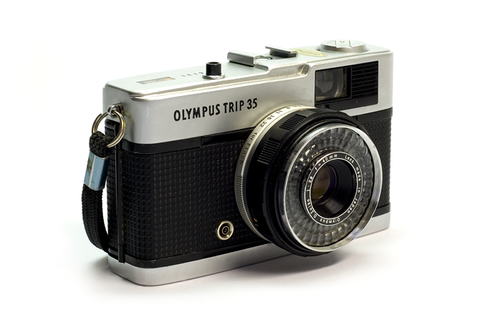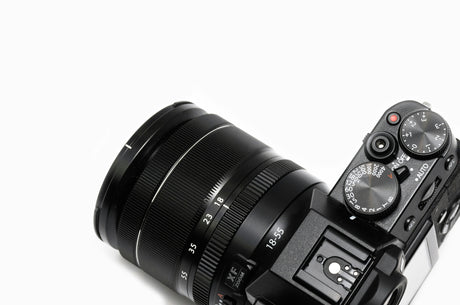One morning I leapt out of bed full of energy, ready to take on the world with my trusty Nikon F and Leica M2. But instead of immersing myself in a world filled with beauty, intrigue, and possibilities, I found my surroundings cold, ugly, and uncaring. The images I was trying to form seemed trite and exaggerated, and I soon lost confidence in my ability to take a decent photo. Not even the famed reputations of my F and M2 inspired me.
Every time he looked through his viewfinders he saw nothing but dust on the pentaprism and emptiness between the frames.
Sufficiently depressed, I decided to stay home and pack my cameras away on the shelf. And it was while lying face down on a pillow listening to the opening lines of Chicago's "Hard To Say I'm Sorry" that I realized I did, in fact, need some time off. But I didn't need a complete vacation from the hobby itself; no, that would be too drastic. I just needed a change from the manual cameras I had on my shelf. I needed a simpler camera, and I had a feeling one camera in particular might be the one: the Olympus Trip 35.

The Olympus Trip 35 is a camera I'd heard a lot about but had never tried. Its reputation for ease of use and high quality seemed like the perfect cure for my photographer's block. And if the Trip 35 was the prescription, the Pasadena Camera Show was the pharmacy. There, I found a beautiful Trip 35 at an absurdly low price, bought it, and promptly stuffed it into my bag.
One might think the Olympus Trip 35 would be out of place next to legendary cameras like the aforementioned Nikon and Leica, but it actually fits right in. This camera, while not as capable as the other two, holds an equally lofty place in the history of photography. Just as the F and M defined the SLR and rangefinder genres respectively, the Trip 35 defined the point-and-shoot game. Even more impressively, the Trip 35 outsold both the Nikon F and the Leica M2. Take that, fanboys.
Olympus achieved these massive numbers by appealing to casual shooters rather than professional photographers, focusing specifically on the new generation of wealthy vacationers. These tourists, rushing from place to place and airport to airport, lacked the time and interest to learn the boring photography details required to operate a camera. Instead, they needed a camera that was simple to use, yet sophisticated enough to capture their memories beautifully.
Good design combines aesthetics with functionality, and the camera gods couldn't have chosen a better company to bring the Trip 35 to life. Fresh off the heels of the ingenious Pen F medium-format camera, Olympus has hit the nail on the head once again with the Trip. The design is classic Olympus; with clean lines and an impossibly small form factor, the Trip wastes no time and gets straight to the point. It's as well-designed as any machine of its era, and it's all the more striking when you remember that the Trip came of age in an age where cameras were still entirely mechanical, save for the occasional battery-powered light meter. Automation seemed like a distant (and expensive) fantasy, so when Olympus created a genuine auto-exposure camera with primitive nuts and bolts, the world took notice. It was, without a doubt, a miracle of engineering.
The Trip 35 performs this magic by determining the amount of light entering a selenium photocell surrounding the lens and choosing the correct aperture based on this reading. The camera then chooses a shutter speed of 1/200 or 1/40 of a second, and we get a perfect exposure. When the camera is unable to make an acceptable exposure, a small red flag appears in the viewfinder, and the shutter locks. The magic of this system is that it takes all exposure-related worries off our minds. We don't have to worry about aperture, shutter speed, or even battery life—a godsend for vacationers and photography enthusiasts.
But before you experience it, it's easy to question the Trip 35's simplicity. After all, how accurate can such an old and primitive camera possibly be? And could the lens ever be good enough for our 21st-century eyes? As I drove home from the camera expo, with my new Trip in the passenger seat, these questions swirled around in my head. I really needed this camera to be decent if I was going to break out of my photographic death spiral.
Just then, I received a text from my sister. Can you buy some pork buns in Chinatown? thx. With that, I had my mission: buy some pork buns, photograph the Journey, and see if this old camera could make the trek.

The first thing I noticed was its build quality. Composed of metal and plastic, the Trip 35 is solid, but never heavy; light, but never flimsy. The only disappointing aspect of the camera is the film advance wheel. This plastic gear, reminiscent of those on disposable cameras, can be forgiven if we remember that the Trip was built to be a consumer camera.
Looking through the viewfinder, you can see bright framing lines with tick marks for both close-up and landscape shots. This is helpful given the Trip's lack of automatic parallax correction. Having used luxury rangefinders from Leica, Nikon, and Contax, renowned for their brightness and clarity, the Trip's viewfinder outperforms most of them. Its relative simplicity is a welcome change from the cluttered and overly complex viewfinders found on other cameras. The Trip 35 also features a small window in the lower right corner of the viewfinder (affectionately nicknamed the "Judas Window" by Trip 35 followers) that displays both the chosen aperture and the camera's exposure setting.
So far, so good. But how would I go about determining focus? I quickly realized that the Trip is a focus-by-scale camera, which isn't ideal for accuracy. But before I started feeling like Olympus had left me helpless and alone, I realized they'd kindly provided some handy tools for measuring distance. The settings along the lens barrel display a one-person image for portraits, two people for two-person shots, three people for group shots, and a mountain symbol for anything in the distance, including mountains. I stopped hyperventilating and realized that, for a point-and-shoot camera, this is more than enough. And for all the nitpickers, Olympus also included precise distance measurements, in both meters and feet, on the bottom of the lens. Phew.
Once shot, the Trip began to shine, and I was able to easily focus on what matters most in photography: composition. From the first frame, I found myself happily shooting whatever took my fancy, even though I didn't know what aperture values and shutter speeds the Trip 35 chose. Frankly, I didn't give a damn. All I cared about was finding different angles, new ways to play with light, and how to capture Chinatown's unique charm. I had the feeling that with each frame, the trip dissolved more and more of my photographer's block, and I wanted to keep shooting.
So little Olympus and I danced through the colorful Chinatown landscape, happily snapping away. It was definitely the most fun I've ever had with a camera. Even though the afternoon heat beat down on my shoulders and sweat sizzled on my forehead, Trip 35 and I ran through the city without a care in the world. The streets led us to the door of a steamy Chinese restaurant, then to a pile of steaming pork buns, and then back again.
into the equally steamy interior of my car. I didn't care how long the trip was or how much fluid I'd lost in that heat wave. I seemed to have sweated out the camera lock, and I ran home to deliver the buns and get the film developed.
But there was one thing that bothered me about the camera all the way home: the focus problem. Had I gotten every shot right? How could I trust those markings? How could I live without a focusing aid? The anxiety started creeping in again, and I had to stop myself from speeding off to a photo lab to calm my fears. I gripped the wheel tightly and told myself to trust the Journey. Besides, I still had work to do. These pork buns weren't going to deliver themselves.
After delivering and eating said pork buns with my overjoyed sister, I decided to develop and scan the roll. My fears were partially justified. Some of the photos, especially those of close subjects or dark scenes, came out blurry due to a combination of my poor distance estimation and the nature of the Trip's exposure and focusing systems. Although the Trip automatically helps achieve sharp focus by selecting a smaller aperture to achieve a greater depth of field, this is only possible in bright light. As it gets darker, the ability to shoot with a smaller aperture quickly disappears. In these situations, it can be really difficult to get focus right. One small consequence of this is that photographers with an affinity for portraiture and those sweet balls of bokeh will likely be disappointed by this camera.
But expecting creamy bokeh and close-range performance from the Trip 35 (or most point-and-shoot cameras) is like expecting a 1993 Honda Civic to outperform a Tesla Model S. It simply won't happen, and the attempt will lead to frustration. But like that Honda, if you treat the Trip 35 as a reliable, casual cruiser, it will never let you down. The Trip 35 is capable of many things, but we must be careful to recognize and respect its own limits.
When focusing properly, the Trip's fantastic Zuiko 40mm f/2.8 lens delivers. The lens is a front-focusing Tessar lens, which means it's very simple and very sharp, and it retains this sharpness from edge to edge without chromatic aberration, spherical aberration, or any kind of distortion due to its simple optical formula and Olympus's masterful execution. The quality of the lens even surpassed the limitations of the expired film and ended up giving me superb results.
Who is this camera best suited for? First, the Trip 35 might be the perfect camera for the casual photophile. Olympus created this camera to document anyone's everyday adventures, and the Trip does that excellently. And for experienced photographers, the Trip 35 can be a great way to break free from photographer's block, or to inject our photographs with some fun and lightheartedness. It emphasizes the art of composition rather than cold exposure calculations, but more importantly, it reminds us to relax, eat a pork bun, and not take ourselves too seriously.























